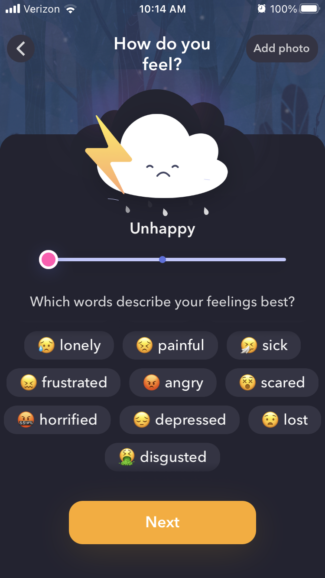DailyBean
LQ: 9.6
Recommended Age: 4+
Skills Used: Self-Awareness, Self-Control, Reading, Writing
 Breeze is an app designed to promote emotional self-awareness and track your moods over a period of time. Every day (or several times a day if needed) the user can check in on the app and list how they are feeling. An animated cloud shows the range of emotions from Unhappy to Happy, with a wide range of options in between. The user then clicks on a wide variety of emotions to clarify how they are feeling. Each emotion is represented in text and emoji form; the user can click on as many emotions as feel appropriate to the situation. After this, the user can then click on activities that occurred that particular day and provide more detailed explanations by typing in specific comments. For example, if a user checked in as sad, they could click on the pets tab and specify that their dog was sick that day.
Breeze is an app designed to promote emotional self-awareness and track your moods over a period of time. Every day (or several times a day if needed) the user can check in on the app and list how they are feeling. An animated cloud shows the range of emotions from Unhappy to Happy, with a wide range of options in between. The user then clicks on a wide variety of emotions to clarify how they are feeling. Each emotion is represented in text and emoji form; the user can click on as many emotions as feel appropriate to the situation. After this, the user can then click on activities that occurred that particular day and provide more detailed explanations by typing in specific comments. For example, if a user checked in as sad, they could click on the pets tab and specify that their dog was sick that day.
Over time, this allows the user to see their emotional spectrum over a period of time in a graph format. They can go back and look at particular days as well to see what brought them joy or what brought on a particularly bad mood.
In addition, the Insights tab allows the user to take several assessments to try and gauge why they are feeling the way they do. They can take the Beck Anxiety or Depression Inventory, giving further insight into certain persistent emotional concerns.
Parents should be aware that, while the app is rated suitable for users 4 and up, the mood check in portion features some sexual health options which may need to be explained for much younger users.
Breeze is available for iOS. Certain features on the app can be used for free but a purchase is required to unlock all features.
 Self-Awareness: Understanding our own actions, thoughts and feelings.
Self-Awareness: Understanding our own actions, thoughts and feelings.
Tracking one’s emotions can be a great path to interpreting and understanding them over a period of time. For children who struggle with expressing how they feel out loud in the moment, taking some time to check in with something as basic as “Very Sad” can be a way of giving their feelings a name. Over time, they can add other markers to this emotion, and maybe even a short explanation as to why they feel the way they do. Over time, revisiting these emotions can help build up a level of self-awareness and emotional intelligence that will help them express how they are feeling in the moment and how they can process those feelings in a healthy way.
Self-Control: Managing our actions, feelings and behaviors.
Once a child is aware of how they are feeling, they can then begin to address actions and behaviors that stem from these emotions. For example, a child who strikes their younger sibling may not even know why they are doing it. But if they have been allowed the space to track their emotions and give feedback about their situation, they can begin to see a pattern and learn to act differently when those situations arise. If the child struck their sibling because they took their toy away, they may see that acting out in anger does not produce the results they want. They can then use this information to adjust their behavior and react differently.
All membership plans come with full access to our entire suite of tools learning guides, and resources. Here are a few of the ones we think you’ll like the most: